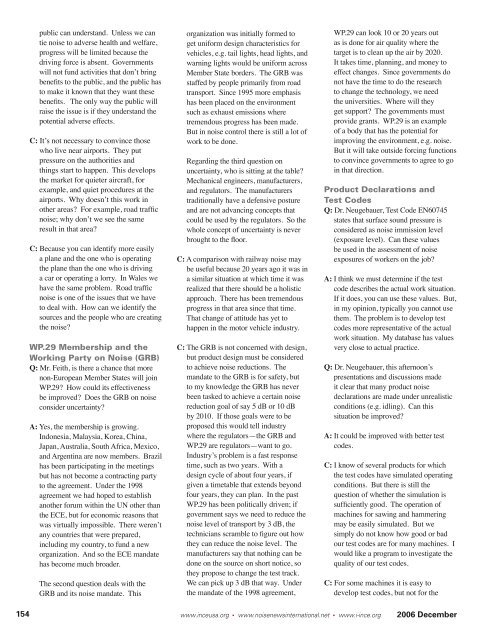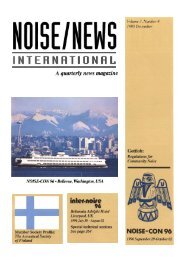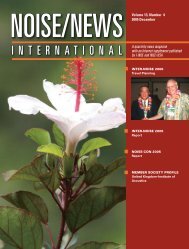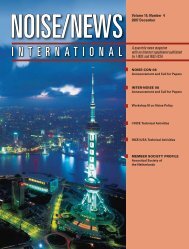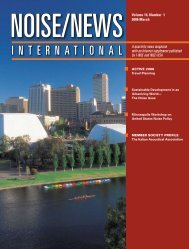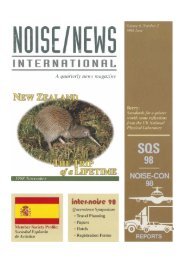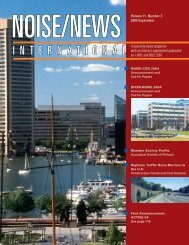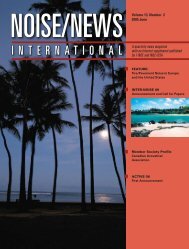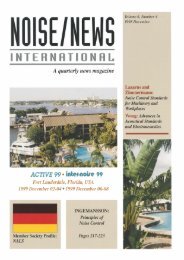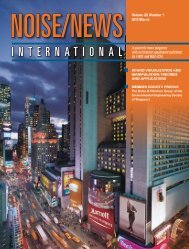Volume 14, Number 4, December, 2006 - Noise News International
Volume 14, Number 4, December, 2006 - Noise News International
Volume 14, Number 4, December, 2006 - Noise News International
Create successful ePaper yourself
Turn your PDF publications into a flip-book with our unique Google optimized e-Paper software.
public can understand. Unless we can<br />
tie noise to adverse health and welfare,<br />
progress will be limited because the<br />
driving force is absent. Governments<br />
will not fund activities that don’t bring<br />
benefits to the public, and the public has<br />
to make it known that they want these<br />
benefits. The only way the public will<br />
raise the issue is if they understand the<br />
potential adverse effects.<br />
C: It’s not necessary to convince those<br />
who live near airports. They put<br />
pressure on the authorities and<br />
things start to happen. This develops<br />
the market for quieter aircraft, for<br />
example, and quiet procedures at the<br />
airports. Why doesn’t this work in<br />
other areas? For example, road traffic<br />
noise; why don’t we see the same<br />
result in that area?<br />
C: Because you can identify more easily<br />
a plane and the one who is operating<br />
the plane than the one who is driving<br />
a car or operating a lorry. In Wales we<br />
have the same problem. Road traffic<br />
noise is one of the issues that we have<br />
to deal with. How can we identify the<br />
sources and the people who are creating<br />
the noise?<br />
WP.29 Membership and the<br />
Working Party on <strong>Noise</strong> (GRB)<br />
Q: Mr. Feith, is there a chance that more<br />
non-European Member States will join<br />
WP.29? How could its effectiveness<br />
be improved? Does the GRB on noise<br />
consider uncertainty?<br />
A: Yes, the membership is growing.<br />
Indonesia, Malaysia, Korea, China,<br />
Japan, Australia, South Africa, Mexico,<br />
and Argentina are now members. Brazil<br />
has been participating in the meetings<br />
but has not become a contracting party<br />
to the agreement. Under the 1998<br />
agreement we had hoped to establish<br />
another forum within the UN other than<br />
the ECE, but for economic reasons that<br />
was virtually impossible. There weren’t<br />
any countries that were prepared,<br />
including my country, to fund a new<br />
organization. And so the ECE mandate<br />
has become much broader.<br />
The second question deals with the<br />
GRB and its noise mandate. This<br />
organization was initially formed to<br />
get uniform design characteristics for<br />
vehicles, e.g. tail lights, head lights, and<br />
warning lights would be uniform across<br />
Member State borders. The GRB was<br />
staffed by people primarily from road<br />
transport. Since 1995 more emphasis<br />
has been placed on the environment<br />
such as exhaust emissions where<br />
tremendous progress has been made.<br />
But in noise control there is still a lot of<br />
work to be done.<br />
Regarding the third question on<br />
uncertainty, who is sitting at the table?<br />
Mechanical engineers, manufacturers,<br />
and regulators. The manufacturers<br />
traditionally have a defensive posture<br />
and are not advancing concepts that<br />
could be used by the regulators. So the<br />
whole concept of uncertainty is never<br />
brought to the floor.<br />
C: A comparison with railway noise may<br />
be useful because 20 years ago it was in<br />
a similar situation at which time it was<br />
realized that there should be a holistic<br />
approach. There has been tremendous<br />
progress in that area since that time.<br />
That change of attitude has yet to<br />
happen in the motor vehicle industry.<br />
C: The GRB is not concerned with design,<br />
but product design must be considered<br />
to achieve noise reductions. The<br />
mandate to the GRB is for safety, but<br />
to my knowledge the GRB has never<br />
been tasked to achieve a certain noise<br />
reduction goal of say 5 dB or 10 dB<br />
by 2010. If those goals were to be<br />
proposed this would tell industry<br />
where the regulators—the GRB and<br />
WP.29 are regulators—want to go.<br />
Industry’s problem is a fast response<br />
time, such as two years. With a<br />
design cycle of about four years, if<br />
given a timetable that extends beyond<br />
four years, they can plan. In the past<br />
WP.29 has been politically driven; if<br />
government says we need to reduce the<br />
noise level of transport by 3 dB, the<br />
technicians scramble to figure out how<br />
they can reduce the noise level. The<br />
manufacturers say that nothing can be<br />
done on the source on short notice, so<br />
they propose to change the test track.<br />
We can pick up 3 dB that way. Under<br />
the mandate of the 1998 agreement,<br />
WP.29 can look 10 or 20 years out<br />
as is done for air quality where the<br />
target is to clean up the air by 2020.<br />
It takes time, planning, and money to<br />
effect changes. Since governments do<br />
not have the time to do the research<br />
to change the technology, we need<br />
the universities. Where will they<br />
get support? The governments must<br />
provide grants. WP.29 is an example<br />
of a body that has the potential for<br />
improving the environment, e.g. noise.<br />
But it will take outside forcing functions<br />
to convince governments to agree to go<br />
in that direction.<br />
Product Declarations and<br />
Test Codes<br />
Q: Dr. Neugebauer, Test Code EN60745<br />
states that surface sound pressure is<br />
considered as noise immission level<br />
(exposure level). Can these values<br />
be used in the assessment of noise<br />
exposures of workers on the job?<br />
A: I think we must determine if the test<br />
code describes the actual work situation.<br />
If it does, you can use these values. But,<br />
in my opinion, typically you cannot use<br />
them. The problem is to develop test<br />
codes more representative of the actual<br />
work situation. My database has values<br />
very close to actual practice.<br />
Q: Dr. Neugebauer, this afternoon’s<br />
presentations and discussions made<br />
it clear that many product noise<br />
declarations are made under unrealistic<br />
conditions (e.g. idling). Can this<br />
situation be improved?<br />
A: It could be improved with better test<br />
codes.<br />
C: I know of several products for which<br />
the test codes have simulated operating<br />
conditions. But there is still the<br />
question of whether the simulation is<br />
sufficiently good. The operation of<br />
machines for sawing and hammering<br />
may be easily simulated. But we<br />
simply do not know how good or bad<br />
our test codes are for many machines. I<br />
would like a program to investigate the<br />
quality of our test codes.<br />
C: For some machines it is easy to<br />
develop test codes, but not for the<br />
154 www.inceusa.org • www.noisenewsinternational.net • www.i-ince.org <strong>2006</strong> <strong>December</strong>


